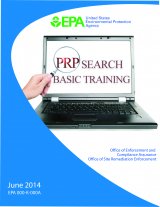Finding Potentially Responsible Parties (PRP)
Early in the cleanup process, EPA conducts a search to find all of the parties (e.g., people, businesses, government entities, etc.) responsible for contamination at a site, known as potentially responsible parties (PRPs). One of the primary objectives is to identify the potentially liable parties at a site. Thorough PRP searches, using many resources which are described below, enhance EPA’s success in negotiating with potentially liable parties to conduct the needed cleanup activities under EPA’s oversight.
Effective PRP searches are fundamental to the Agency's “enforcement first” strategy of maximizing PRP involvement in conducting cleanup response activities. When PRPs are identified and notified early in the Superfund cleanup process, there is a greater likelihood that they will decide to negotiate a settlement agreement with the Agency on the appropriate action to address contamination at the site. Additionally, negotiating with PRPs to perform or pay for the cleanup work at a site saves taxpayer dollars and preserves funding for sites that have no identifiable PRPs.
On this page:
PRP Searches in the Enforcement Process
EPA looks for evidence that shows that PRPs are liable for contamination by matching wastes found at the site with parties that may have contributed wastes to the site. EPA uses many approaches to do this research, including:
- Reviewing documents, conducting title searches, and researching information about the facility and parties on the web, in libraries, and state and federal government resources,
- Conducting investigation and sampling at sites,
- Interviewing people that may have information about the general operation of the site, which can include community members, and
- Sending "information request letters" to PRPs to provide the Agency with additional information they may have. The letters are used to gather information, but it does not designate a party as a PRP.
Part of the work to identify a PRP also includes determining early on:
- The nature of a party's involvement (e.g., whether the PRP was the owner or operator at the site, generated waste that was sent to the site, or decided to transport waste to the site),
- A party's potential legal defenses to Superfund liability (e.g., 3rd party defense),
- Any applicable legal exemptions or exclusions that would prevent EPA from entering into a cleanup agreement or issuing a cleanup order,
- The amount of waste a party contributed, and
- Whether the party can pay a limited amount or nothing at all toward the cleanup.
PRP Search Manual

EPA's "PRP Search Manual" (2017) provides guidance on how to search for PRPs that may be liable for cleanup at a Superfund site. The manual, divided into four chapters and appendices, gives the user historical background on Superfund and its enforcement program, and describes the planning stages, baseline tasks, and follow up tasks for conducting effective PRP searches.
Access the complete edition or individual chapters and appendices of the 2017 PRP Search Manual.
PRP Search Basic Training Video Collection

The eight-part video training is intended to help federal and state environmental departments and agencies conduct thorough and accurate PRP searches. The videos cover the major steps and considerations taken throughout the search process in relation to Superfund's cleanup response process. The videos, along with accompanying resource materials, guide you through the process of gathering information, conducting interviews, compiling data, and contacting PRPs. The PRP Search Basic Training Handbook contains content related to each of the video sessions, document examples discussed during the training, and reference materials.
Access the collection of videos and basic training handbook.
Learn More about finding PRPs:
Related Information:
